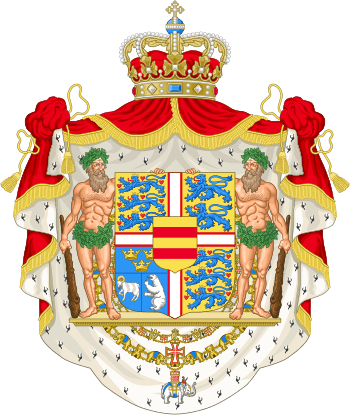Olav V of Norway
Olav V (born Prince Alexander of Denmark; 2 July 1903 – 17 January 1991) was King of Norway from 1957 until his death.
| Olav V | |||||
|---|---|---|---|---|---|
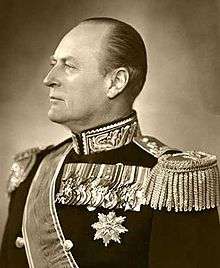 King Olav in 1957 | |||||
| King of Norway | |||||
| Reign | 21 September 1957 – 17 January 1991 | ||||
| Benediction[lower-alpha 1] | 22 June 1958 | ||||
| Predecessor | Haakon VII | ||||
| Successor | Harald V | ||||
| Prime Ministers | |||||
| Born | Prince Alexander of Denmark 2 July 1903 Appleton House, Sandringham, Norfolk, England | ||||
| Died | 17 January 1991 (aged 87) The Royal Lodge, Holmenkollen, Oslo, Norway | ||||
| Burial | 30 January 1991 Akershus Castle, Oslo | ||||
| Spouse | |||||
| Issue | |||||
| |||||
| House | Glücksburg | ||||
| Father | Haakon VII of Norway | ||||
| Mother | Maud of Wales | ||||
| Medal record | ||
|---|---|---|
| Sailing | ||
| Representing | ||
| Olympic Games | ||
| 1928 Amsterdam | 6 m mixed | |
| 5.5 Metre World Championships | ||
| 1971 Seawanhaka | 5.5m | |
| 1976 Hankø | 5.5m | |
Olav was the only child of King Haakon VII of Norway and Maud of Wales. He became heir apparent to the Norwegian throne when his father was elected King of Norway in 1905. He was the first heir to the Norwegian throne to be brought up in Norway since Olav IV in the fourteenth century, and his parents made sure he was given as Norwegian an upbringing as possible. In preparation for his future role, he attended both civilian and military schools. In 1929, he married his first cousin Princess Märtha of Sweden. During World War II his leadership was much appreciated and he was appointed Norwegian Chief of Defence in 1944. Olav became king following the death of his father in 1957.
Owing to his considerate, down-to-earth style, King Olav was immensely popular, resulting in the nickname Folkekongen ("The People's King"). In a 2005 poll by the Norwegian Broadcasting Corporation, Olav was voted "Norwegian of the Century".[1]
Birth and early life
.jpg)
Olav was born Prince Alexander Edward Christian Frederik in Appleton House on the royal Sandringham Estate, Flitcham, United Kingdom.[2] His parents were Prince Carl, second son of Crown Prince Frederick of Denmark (later King Frederick VIII), and Princess Maud, youngest daughter of King Edward VII of the United Kingdom, who was the eldest son of Britain's Queen Victoria. In 1905, Carl was elected king of Norway and took the name Haakon VII. On the day Haakon was crowned, he gave his two-year-old son the Norwegian name Olav after Olaf Haakonsson, king of Norway and Denmark.[3]
Olav was thus the first heir to the throne since the Middle Ages to have been raised in Norway. Unlike his father, who was a naval officer, Olav chose to complete his main military education in the army. He graduated from the three-year Norwegian Military Academy in 1924, with the fourth best score in his class. Olav then went on to study jurisprudence and economics for two years at Balliol College, Oxford.[4]
During the 1930s, Crown Prince Olav was a naval cadet serving on the minelayer/cadet training ship Olav Tryggvason.[5] Olav moved up the ranks of the Norwegian armed forces, rising in the army from an initial rank of first lieutenant to captain in 1931 and colonel in 1936.[6]
He was an accomplished athlete. Olav jumped from the Holmenkollen ski jump in Oslo and competed in sailing regattas. He won a gold medal in sailing at the 1928 Summer Olympics[7] in Amsterdam and remained an active sailor into old age.
On 21 March 1929 in Oslo, he married his first cousin Princess Märtha of Sweden with whom he had two daughters, Ragnhild and Astrid and one son, Harald. As exiles during World War II, Crown Princess Märtha and the royal children lived in Washington, D.C., where she struck up a close friendship with Franklin D. Roosevelt. She died in 1954, before her husband ascended the throne.
The British Film Institute houses an early film, made in 1913, in which a miniature car (a "baby Cadillac") commissioned by Queen Alexandra for Crown Prince Olav tows a procession of Londoners through the streets of the capital, before being delivered to a pair of "royal testers" of roughly Olav's age.[8] The car is a battery-powered, one-third size replica on a four-foot wheelbase, and is on permanent loan to the Norsk Teknisk Museum in Oslo.[9]
World War II
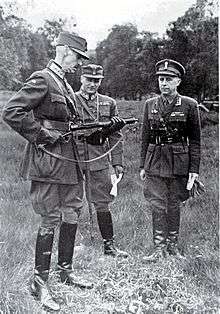
As Crown Prince, Olav had received extensive military training and had participated in most major Norwegian military exercises. Because of this he was perhaps one of the most knowledgeable Norwegian military leaders and was respected by other Allied leaders for his knowledge and leadership skills. During a visit to the United States before the war, he and his wife had established a close relationship with President Roosevelt. These factors would prove to be important for the Norwegian fight against the attacking German forces. In 1939, Crown Prince Olav was appointed an admiral of the Royal Norwegian Navy and a general of the Norwegian Army.[6]
During World War II, Olav stood by his father's side in resisting the German occupation of Norway. During the campaign he was a valuable advisor both to civilian and military leaders. When the Norwegian government decided to go into exile, he offered to stay behind with the Norwegian people, but this was declined. He reluctantly followed his father to the United Kingdom, where he and his staff and servants and aides continued to be a key advisor to the government-in-exile and his father. It is a popular legend among his countrymen that he did not allow himself any dessert or sweets for the duration of the Norwegian occupation. Olav made several visits to Norwegian and Allied troops in the United Kingdom, Canada and the United States. In 1944, he was appointed to the post of Norwegian Chief of Defence and after the war he led the Norwegian disarmament of the German occupying forces. His war decorations from other nations, including the War Crosses of Norway, France, Greece and the Netherlands, the US Legion of Merit and the French Médaille Militaire, are testament to the international recognition of his contribution to the war against Hitler.

| Norwegian Royalty House of Oldenburg (Glücksburg branch) |
|---|
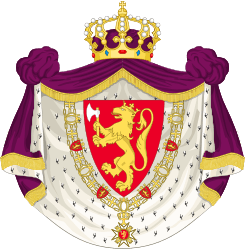 |
| Haakon VII |
|
| Olav V |
| Harald V |
|
Reign

Succeeding to the Norwegian throne in 1957 upon his father's death, Olav reigned as a "People's King," and became extremely popular. He liked to drive his own cars, and would drive in the public lanes, even though as a monarch he was allowed to drive in bus lanes. During the 1973 energy crisis driving was banned on certain weekends. King Olav never wanted to miss an opportunity to go skiing, and while he could have driven legally, he wanted to lead by example. So he dressed up in his skiing outfit, and boarded the Holmenkollbanen suburban railway carrying his skis on his shoulder.[10] He was later asked how he dared to go out in public without bodyguards. He replied that "he had 4 million bodyguards" —the population of Norway was at the time 4 million.
For his athletic ability and role as King, Olav earned the Holmenkollen medal in 1968, the Medal for Outstanding Civic Achievement in 1970 and was made Name of the Year in 1975. He had a strong interest in military matters and took his role as titular Commander-in-Chief very seriously. As well as his ceremonial roles in the Norwegian Army, he also served as Colonel-in-Chief of the Green Howards (Alexandra, Princess of Wales's Yorkshire Regiment), the British regiment named for his grandmother Queen Alexandra.
The King represented Norway extensively abroad during his reign, conducting state visits to both neighbouring countries and more distant destinations such as Ethiopia and Iran. King Olav V opened the 14th World Scout Jamboree in July 1975 in the presence of 17,259 Scouts from 94 countries.
Although the constitution nominally vested Olav with executive power, he was not responsible for exercising it. His acts were not valid without the countersignature of a minister–usually the Prime Minister–who then became politically responsible for the act in question. He had the right to appoint the government, but in practice it was not possible for him to keep a government in office against the will of the Storting. Thus, in practice, his role was mostly representative and ceremonial in nature. Nonetheless, like his father before him, he commanded great moral authority as a symbol of the nation's unity.
Illness and death
During the summer of 1990, the King suffered from health problems, but recovered somewhat during Christmas the same year. At the age of 87, on 17 January 1991, while residing in the Royal Lodge Kongsseteren in Oslo, he became ill and died in the evening of a myocardial infarction. An interview given by King Harald V and hints in a biography by Jo Benkow, who was the President of the Storting at that time, mention the possibility that King Olav suffered great trauma upon learning of the outbreak of the first Gulf War, which began the day of his death. Olav's son Harald V succeeded him as King.
On the night of his death and for several days up until the state funeral, Norwegians mourned publicly, lighting hundreds of thousands of candles in the courtyard outside the Royal Palace in Oslo, with letters and cards placed amongst them.[11] The National Archives have preserved all these cards.
Funeral
The state funeral of King Olav V was held on 30 January 1991. During the funeral procession from the Royal Palace to Oslo Cathedral, over 100,000 people lined up along Karl Johans gate to pay their respects.[12] Prime Minister Gro Harlem Brundtland gave the eulogy at the funeral, before the casket was moved to Akershus Fortress where a private service was held.[13]
Olav was finally laid to rest next to his wife Märtha in the green sarcophagus of the Royal Mausoleum.[14]
Legacy
King Olav's leadership during the Second World War made him a symbol of Norwegian independence and national unity. As King Olav's wife, Princess Märtha, died of cancer, the King Olav V's Prize for Cancer Research was established in 1992.
A 2005 poll by the Norwegian Broadcasting Corporation named King Olav "Norwegian of the Century".[1]
In popular culture
Viktor Andersen portrayed the two-year old Prince Alexander (Olav) in the 2009 NRK drama series Harry & Charles. Actor Anders Baasmo Christiansen was chosen to portray Crown Prince Olav in the 2016 drama The King's Choice.
Titles, styles and honours
| Styles of King Olav V of Norway | |
|---|---|
| Reference style | His Majesty |
| Spoken style | Your Majesty |
Titles and styles

- 2 July 1903 – 18 November 1905: His Highness Prince Alexander of Denmark
- 18 November 1905 – 21 September 1957: His Royal Highness The Crown Prince of Norway
- 21 September 1957 – 17 January 1991: His Majesty The King of Norway
National honours and medals









Foreign honours


.svg.png)
.svg.png)






.svg.png)





.svg.png)
.svg.png)
.svg.png)
- Recipient of the Commemorative Badge of the Centenary of the Royal House of Greece

.svg.png)
.svg.png)











.svg.png)








.svg.png)










.svg.png)
Other honours









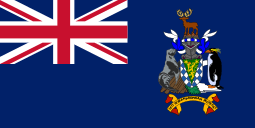

Issue
| Children | Birth | Death | Married | Grandchildren | Great-Grandchildren | Great-Great-Grandchildren |
|---|---|---|---|---|---|---|
| Princess Ragnhild of Norway | 9 June 1930 | 16 September 2012 | married 1953, Erling Lorentzen | Haakon Lorentzen (b.1954)
Ingeborg Lorentzen Ribeiro (b.1957) Ragnhild Lorentzen Long (b.1968) |
Olav Lorentzen (b.1985)
Christian Lorentzen (b.1988) Sophia Lorentzen (b.1994) Victoria Ribeiro Falcao (b.1988) Alexandra Long (b.2007) Elizabeth Long (b.2011) |
Frederik Falcao (b.2016) |
| Princess Astrid of Norway | 12 February 1932 | married 1961, Johan Ferner | Cathrine Ferner Johansen (b.1962)
Benedikte Ferner (b.1963) Alexander Ferner (b.1965) Elisabeth Ferner Beckmann (b.1969) Carl-Christian Ferner (b.1972) |
Sebastian Johansen (b.1990)
Madeleine Johansen (b.1993) Edward Ferner (b.1996) Stella Ferner (b.1998) Benjamin Beckmann (b.1999) Fay Ferner (b.2018) |
Nicoline Johansen (b.2019) | |
| Harald V of Norway | 21 February 1937 | married 1968, Sonja Haraldsen | Princess Märtha Louise (b.1971)
Crown Prince Haakon Magnus (b.1973) |
Maud Behn (b.2003)
Leah Behn (b.2005) Emma Behn (b.2008) Princess Ingrid Alexandra (b.2004) Prince Sverre Magnus (b.2005) |
Gallery
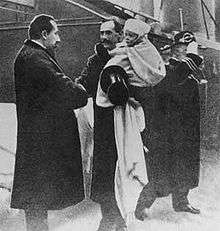
Crown Prince Olav arrives in Norway in 1905 on his father's arm and is greeted by Prime Minister Christian Michelsen 
Drawing, 1906, by Andreas Bloch  Märtha and Olav on the cover of Time on the occasion of their wedding
Märtha and Olav on the cover of Time on the occasion of their wedding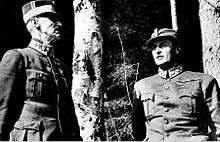
Crown Prince Olav and his father King Haakon VII take shelter under birch trees as the German Luftwaffe bombs Molde 
Märtha and Olav in 1950. 
Olav in 1921 as Crown Prince.  Haakon VII of Norway, Maud of Wales and Crown Prince Olav on 17 July 1913 in Norway
Haakon VII of Norway, Maud of Wales and Crown Prince Olav on 17 July 1913 in Norway
References
- Coronation discarded by constitutional amendment in 1908. Olav V instead received benediction in Nidaros Cathedral.
- "Folkekongen ble århundrets nordmann". Aftenposten (in Norwegian). 17 December 2005. Retrieved 14 July 2011.
- Sandelson, Michael (28 October 2011). "Norway's Queen Maud in euthanasia speculations". The Foreigner. Retrieved 9 July 2013.
- "Olav to Martha". Time Magazine. 21 January 1929. Retrieved 17 January 2009.
- Benkow 1991, pp. 97-108.
- Bratli & Schau 1995, p. 93.
- Dahl 1982, p. 48.
- Flint 1991.
- F.S. Bennett (Director) (1913). The Smallest Car in the Largest City in the World (motion picture). London, England: British Film Institute. Retrieved 15 May 2017 – via YouTube.
- Morton, Ian (30 August 2003). "Right Royal Fun in a Baby Cadillac". The Daily Telegraph. Retrieved 15 May 2017.
- Article from NRK on the king Featuring a photo of the event and explanatory text (in Norwegian). Retrieved 24 November 2006
- "Tronskiftet 1991". www.kongehuset.no (in Norwegian). Retrieved 13 April 2018.
- AS, TV 2. "I dag er det 25 år siden kong Olav døde". TV 2 (in Norwegian). Retrieved 13 April 2018.
- Berge, Jørgen. "Gro: - Jeg hadde et nært forhold til kong Olav". Nettavisen (in Norwegian). Retrieved 13 April 2018.
- Dahlmann, L. A. "The secret journey of Queen Maud's coffin | norwegianhistory.no". Archived from the original on 9 February 2019. Retrieved 7 February 2019.
- Badraie Archived 5 March 2016 at the Wayback Machine
- "People". Time Magazine. 26 October 1962. p. 1. Retrieved 17 January 2009.
- Royal House of Norway web page on King Olav V's decorations (Norwegian) Retrieved 5 October 2007
- "No. 41815". The London Gazette (Supplement). 11 September 1959. p. 5791.
- Solholm, Rolleiv (14 November 2008). "King Harald receives honorary title". Norwegian Broadcasting Corporation. Norway Post. Retrieved 4 May 2013.
- Suits 2011, p. 53.
Bibliography
- Benkow, Jo (1991). Olav – menneske og monark (in Norwegian) (3rd ed.). Oslo: Gyldendal Norsk Forlag. ISBN 82-05-20192-7.CS1 maint: ref=harv (link)
- Bratli, Kjell Arne; Schau, Øyvind (1995). Sjøoffiser og samfunnsbygger : Vernepliktige sjøoffiserers forening : 100-års jubileumsbok : 1895–1995 (in Norwegian). Hundvåg: Sjømilitære Samfund ved Norsk Tidsskrift for Sjøvesen. ISBN 82-91008-09-4.CS1 maint: ref=harv (link)
- Dahl, Hans Fredrik (1982). Norge under Olav V (in Norwegian). Oslo: Cappelen. ISBN 8202090520.CS1 maint: ref=harv (link)
- Flint, Peter B. (18 January 1991). "Olav V, Norway's King 33 Years And Resistance Hero, Dies at 87". New York Times.CS1 maint: ref=harv (link)
- Suits, Julia (2011). The Extraordinary Catalog of Peculiar Inventions: The Curious World of the Demoulin Brothers and Their Fraternal Lodge Prank Machi nes - from Human Centipedes and Revolving Goats to ElectricCarpets and SmokingC. Penguin Publishing Group. p. 53. ISBN 978-1-101-54576-8.CS1 maint: ref=harv (link)
External links
| Wikimedia Commons has media related to Olav V of Norway. |
- Official Website of the Royal House of Norway
- King Olav – biography (Official Website of the Royal House of Norway)
- The Royal Norwegian Order of St Olav – H.M. King Olav V the former Grand Master of the Order
- Holmenkollen medalists – click Holmenkollmedaljen for downloadable pdf file (in Norwegian)
- Newspaper clippings about Olav V of Norway in the 20th Century Press Archives of the ZBW
Olav V House of Schleswig-Holstein-Sonderburg-Glücksburg Cadet branch of the House of Oldenburg Born: 2 July 1903 Died: 17 January 1991 | ||
| Regnal titles | ||
|---|---|---|
| Preceded by Haakon VII |
King of Norway 1957–1991 |
Succeeded by Harald V |
| Norwegian royalty | ||
| Preceded by Gustaf |
Crown Prince of Norway 1905–1957 |
Succeeded by Harald |
| Military offices | ||
| Preceded by Wilhelm von Tangen Hansteen |
Chief of Defence of Norway 1944–1945 |
Succeeded by Otto Ruge |
